The Origin and Architectural and Technological Characteristics and Opportunities for the Reuse of Portugal’s EPAC Silo Network
Abstract
1. Introduction
2. Materials and Methods
3. Results and Discussion
3.1. Geographical Distribution, Development, and Evolution of the EPAC Silo Network
3.2. Layout and Construction Characteristics
3.2.1. Early Silos
3.2.2. Silos from the 1970s
3.2.3. Construction Features
3.3. Technological Development
3.3.1. Early Silos
3.3.2. Silos from the 1970s
3.3.3. Port Silos
3.4. Possibilities of Reuse for Portugal’s Silos
4. Conclusions
Supplementary Materials
Author Contributions
Funding
Institutional Review Board Statement
Data Availability Statement
Acknowledgments
Conflicts of Interest
References
- Teague, W.D. Flour for Man’s Bread: A History of Milling; Minnesota Archive Editions; University of Minnesota Press: New York, NY, USA, 2007. [Google Scholar]
- Pereira, J.L. Contribución fiscal del partido de Cáceres durante el siglo XVI: Alcabalas y tercias. Norba. Rev. Arte Geogr. E Hist. 1980, 1, 71–72. Available online: http://hdl.handle.net/10662/810 (accessed on 8 January 2024).
- Banham, R. A Concrete Atlantis. In US Building and European Modern Architecture; MIT Press: Cambridge, MA, USA, 1989. [Google Scholar]
- Salido, J. El almacenamiento de cereal en los establecimientos rurales hispanorromanos. In Horréa d’Hispanie et de la Méditerranée Romaine; Arce, J., Goffaux, B., Eds.; Casa de Velázquez: Madrid, Spain, 2011; pp. 127–141. [Google Scholar]
- Fernández-Fernández, M.V. Catalogación de Las Unidades de Almacenamiento Vertical de Cereales de la Red Básica de Castilla Y León, Propuesta de Una Nueva Clasificación Y Posibilidades de Reutilización. Master’s Thesis, University de León, León, Spain, 2016. [Google Scholar]
- DG. Lei de 15 de Julio de 1889. Diário do Governo n.º 156/1889 de 16 de Julho.
- DG. Decreto de 29 de Agosto de 1889. Diário do Governo n.º 198/1889 de 4 de Setiembre.
- DG. Lei de 14 de Julio de 1899. Diário do Governo n.º 156/1899 de 15 de Julho.
- Amaral, L. Política e economia: O Estado Novo, os latifundiários alentejanos e os antecedentes da EPAC. Anal. Soc. 1996, 31, 465–486. [Google Scholar]
- Ribeiro, I.; Diniz, A. Celeiro Epac. A Paisagem Industrial de Évora. Sci. Antiq. 2019, 2, 153–176. [Google Scholar]
- Reis, J. “Lei da Fome”: As origens do proteccionismo cerealífero (1889–1914). Análise Soc. 1979, 15, 745–793. [Google Scholar]
- Alves, J.A. Arquiteturas do Trigo: Espaços de Silagem no Alentejo, do Século XIX à Atualidade. Master’s Thesis, Universidade de Évora, Évora, Portugal, 2016. Available online: http://hdl.handle.net/10174/19745 (accessed on 8 January 2024).
- Pais, J.M. Elementos para a história do fascismo nos campos: A campanha do trigo: 1928–1938 (I). Análise Soc. 1976, 12, 401–473. [Google Scholar]
- Machado, J.; Valadas, A.M.; Ferrerira, J.; Marques, M.F.; Gameiro, M.M. Elementos para a história do fascismo nos campos: A «Campanha do Trigo»: 1928–1938 (II). Análise Soc. 1978, 14, 321–389. [Google Scholar]
- Pratas, A.M. Arquitectura e Memoria. Proposta de Reabilitaçao das Moagens de Mértola. Master’s Thesis, Universidade de Coimbra, Coimbra, Portugal, 2018. [Google Scholar]
- FNPT. Federação Nacional de Produtores de Trigo: XXV Aniversario; Federação Nacional de Produtores de Trigo: Lisboa, Portugal, 1958. [Google Scholar]
- Galvão, J.M. A Campanha do Trigo: Comemoração do seu Trigésimo Aniversário: Discurso Proferido na Inauguração do Marco Comemorativo em Agua de Peixes-Viana do Alentejo em 28/12/59; Minerva Commercial: Beja, Portugal, 1960. [Google Scholar]
- Lucena, M. Salazar, a «fórmula» da agricultura portuguesa e a intervençao estatal no sector primario. Análise Soc. 1991, 26, 97–206. Available online: https://www.jstor.org/stable/41010848 (accessed on 8 January 2024).
- Palomares, S.; Viscomi, P.; Quintas, A. La patrimonalización rural del sur ibérico. 4rth international congress for heritage education and socialisation in rural áreas. Zalamea Serena Descomunal. Rev. Iberoam. Patrim. Y Comunidad 2016, 1, 187–200. [Google Scholar]
- Mayer, R. Estabelecimento de Silos Para Trigo em Portugal: Relatório Apresentado à Federação Nacional dos Produtores de Trigo; Tipográfica, S., Ed.; Livraria Castro e Silva: Lisbon, Portugal, 1938. [Google Scholar]
- Lyttelton, A. Liberal and Fascist Italy: Short Oxford History of Italy: 1900–1945; Davis, J.A., Ed.; Oxford University Press: Oxford, UK, 2002. [Google Scholar]
- Clough, S.B. The Economic History of Modern Italy; Columbia University Press: New York, NY, USA, 1964. [Google Scholar]
- Ferreira-Lopes, P.; Mateo, C.; Landi, S. La Historia y Fundamentos de la Construcción de la Red Nacional de Silos Mediante un Análisis Comparativo Entre España, Italia y Portugal. In Proceedings of the XII Congreso Nacional y Cuarto Congreso Internacional Hispoanoamericono de Historia de la Construcción, Mieres, Spain, 4–8 October 2022. [Google Scholar]
- Fernández-Fernández, M.V.; Marcelo, V.; Valenciano, J.B.; González-Fernández, A.B. Characterisation of the National Network of Silos and Granaries in Castilla y León, Spain: A Case Study. Sustainability 2023, 15, 3755. [Google Scholar] [CrossRef]
- Palmeiro, A. Postais Ilustradros: UM Olhar Sobre os Silos do Distrito de Portalegre. In Proceedings of the III Seminário de I&DT, Centro Interdisciplinar de Investigação e Inovação, Instituto Politécnico de Portalegre, Portalegre, Portugal, 6–7 December 2012. [Google Scholar]
- DRE. Decreto-Lei 663/76 de 4 agosto de 1976, Institui as Empresas Públicas Empresa Pública do Abastecimento de Cereais (EPAC) e Instituto dos Cereais, E.P. (ICEP), e Aprova os Respectivos Estatutos. Diário da República (Portugal) n.º 181/1976. Série I de 1976-08-04. Available online: https://dre.tretas.org/dre/111961/decreto-lei-663-76-de-4-de-agosto (accessed on 8 January 2024).
- EPAC. História. Available online: https://epac-comercial.webnode.pt/historia/ (accessed on 8 January 2024).
- Fernández-Fernández, M.V.; Marcelo, V.; Valenciano, J.B.; López, F.J. History, construction characteristics and possible reuse of Spain’s network of silos and granaries. Land Use Policy 2017, 63, 298–311. [Google Scholar] [CrossRef]
- DRE. Decreto-Lei 26/91 de 11 de Janeiro, Transforma A Empresa Pública de Abastecimento de Cereais (EPAC) em Sociedade Anónima. Diário da República (Portugal) n.º 9/1991, Série I-A de 1991-01-11, 175-180. Available online: https://dre.pt/dre/detalhe/decreto-lei/26-693841 (accessed on 8 January 2024).
- DRE. Decreto-Lei 572-A/99 de 29 de Dezembro, Determina a Dissolução e Regula a Liquidação da EPAC—Empresa Para Agroalimentação e Cereais, S.A. Diário da República (Portugal) n.º 301/1999, 1º Suplemento, Série I-A de 1999-12-29, 2-3. Available online: https://data.dre.pt/eli/dec-lei/572-a/1999/12/29/p/dre/pt/html (accessed on 8 January 2024).
- DRE. Decreto-Lei nº 188/2001 de 25 de Junho, Regula o Processo de Liquidação da SILOPOR—Empresa de Silos Portuários, S.A., e Estabelece um Conjunto de Regras Sobre a Concessão da Actividade da Empresa. Diário da República (Portugal) n.º 145/2001, Série I-A de 2001-06-25. Available online: https://dre.tretas.org/dre/142331/decreto-lei-188-2001-de-25-de-junho (accessed on 8 January 2024).
- Vaquero, M. Innovation in times of autarky: The construction of the wheat silos in Fascist Italy. Fabrikart 2011, 10, 264–277. [Google Scholar]
- Verde, P. Representaçao Tipológica Através da Fotografía Silos no Alentejo, Partindo da Obra de Bernd e Hila Becher. Master’s Thesis, Universidade de Evora, Evora, Portugal, 2010. [Google Scholar]
- Maurílio, F. As arquiteturas do cereal em Évora. In Património Industrial Ibero-Americano: Recentes Abordagens; Palomares, S., Quintas, A., de Lima, F., Viscomi, P., Eds.; Biblioteca Estudos & Colóquios, Universidad de Evora: Évora, Portugal, 2020; Serie e-books nº 22; Available online: https://books.openedition.org/cidehus/13907#text (accessed on 8 January 2024).
- Benito, P. Patrimonio industrial y cultura del territorio. Boletín Asoc. Geogr. Esp. 2002, 34, 213–227. [Google Scholar]
- Mateo, C. Red Nacional de Silos y Graneros de España. In Proceedings of the III International Venue of the Agriculture and Food Production Section of TICCIH, Nogent-sur-Seine, France, 20–22 October 2011. [Google Scholar]
- Fernández-Fernández, M.V.; Marcelo, V.; Valenciano, J.B.; Boto, J. Catalogación de los silos pertenecientes a la red española de silos y graneros en Castilla y León. In Proceedings of the IX Congreso Ibérico de Agroengenharia, Braganza, Portugal, 4–6 September 2017. [Google Scholar]
- Fernández-Fernández, M.V.; Marcelo, V.; Valenciano, J.B.; López, F.J.; Pastrana, P. Spain’s national network of silos and granaries: Architectural and technological change over time. Span. J. Agric. Res. 2020, 18, e0205. [Google Scholar] [CrossRef]
- Han, S.; Zhang, H. Progress and Prospects in Industrial Heritage Reconstruction and Reuse Research during the Past Five Years: Review and Outlook. Land 2022, 11, 2119. [Google Scholar] [CrossRef]
- Giuliani, F.; De Falco, A.; Landi, S.; Bevilacqua, M.G.; Santini, L.; Pecori, S. Reusing grain silos from the 1930s in Italy. A multi-criteria decision analysis for the case of Arezzo. J. Cult. Herit. 2018, 29, 145–159. [Google Scholar] [CrossRef]
- Salamanca, D.; Mateo, C.; Moreno, M.; Rodríguez, L.; Alarcón, A. Red Nacional de Silos. Integración en la Realidad Urbana Andaluza y su Reutilización Para Nuevas Tipologías; Junta de Andalucía: Sevilla, Spain, 2011; pp. 45–50. Available online: https://ws132.juntadeandalucia.es/publicaciones/Proyectosdeinvestigacion/45_Red%20Nacional%20de%20Silos/RNSG_tomo%201.pdf (accessed on 8 January 2024).
- Marcelo, V.; Valenciano, J.B.; López, J.; Pastrana, P. The D5 Silo of Manganeses of the Lampreana (Zamora): History, construction characteristics and technology. In Proceedings of the European Conference on Agricultural Engineering AgEng2021, Évora, Portugal, 4–8 July 2021; Volume 2. Available online: https://www.corpuspublishers.com/assets/articles/aart-v2-21-1028.pdf (accessed on 8 January 2024).
- Azcárate, C.A. Catedrales Olvidadas, La Red Nacional de Silos en España 1949–1990, T6 ed.; Ministerio de Medio Ambiente y Medio Rural y Marino: Madrid, Spain, 2009.
- CME. Parecer de Construção de um Silo Para 20000 Toneladas na Horta das Figueiras em Évora; Acessível no Divisão de Gestão Urbanística da Câmara Municipal de Évora: Évora, Portugal, 1969. [Google Scholar]
- Sociedade de Construções Valura LDA. Memória Descritiva de Silos Para 20000 Toneladas em Évora; Acessível no Divisão de Gestão Urbanística da Câmara Municipal de Évora: Évora, Portugal, 1970. [Google Scholar]
- Barciela, C.F. La modernización de la agricultura y la política agraria. Papeles Econ. Esp. 1997, 73, 112–133. [Google Scholar]
- Moreno, A. Un análisis tecnológico sobre la red nacional de silos y graneros desde la ingeniería industrial en el ámbito agrario: ¿con qué maquinaria y cómo funcionaban? In Proceedings of the I Jornadas de Patrimonio Industrial Agrario: Silos a Debate, Badajoz, Spain, 26–28 September 2014. [Google Scholar]
- Instituto Nacional de Estatística Portugal. Estatística Agrícolas 2022. Available online: https://www.ine.pt/xportal/xmain?xpid=INE&xpgid=ine_publicacoes&PUBLICACOESpub_boui=620831430&PUBLICACOESmodo=2 (accessed on 21 February 2024).
- The Declaration of Amsterdam—1975. Available online: https://www.icomos.org/en/and/169-the-declaration-of-amsterdam (accessed on 21 February 2024).
- Pardo, C.J. El patrimonio industrial en España: Análisis turístico y significado territorial de algunos proyectos de recuperación. Boletín Asoc. Geogr. Esp. 2010, 53, 239–264. [Google Scholar]
- Fuentes, J.M.; López-Sánchez, M.; García, A.I.; Ayuga, F. Public abattoirs in Spain: History, construction characteristics and the possibility of their reuse. J. Cult. Herit. 2015, 16, 632–639. [Google Scholar] [CrossRef]
- Fuentes, J.M.; García, A.I.; Ayuga, E.; Ayuga, F. The development of the flour-milling industry in Spain: Analysis of its historical evolution and architectural legacy. J. Hist. Geogr. 2011, 37, 232–241. [Google Scholar] [CrossRef]
- Matoso, R. Visita a antigos espaços industriais—Antigos Celeiros da Epac e Antiga Fábrica de escolha de sementes de trigo. In Ciclo de Conferências «Cultura, Espaço Público e Desenvolvimento—Que Opções Para uma Política Cultural Transformadora»; Universidade de Évora: Évora, Portugal, 2014; pp. 33–36. [Google Scholar]
- MZ. Museo Zer0. Available online: https://www.museu0.pt/ (accessed on 8 January 2024).
- Radiopax. Mértola: Antigos Celeiros da EPAC vão Transformar-se numa Estação Biológica. Available online: https://www.radiopax.com/mertola-antigos-celeiros-da-epac-vao-transformar-se-numa-estacao-biologica/ (accessed on 8 January 2024).
- Aguilar, E.; Merino, D.; Migens, M. Cultura, políticas de desarrollo y turismo rural en el ámbito de la globalización. Horiz. Antropol. 2003, 20, 161–183. [Google Scholar] [CrossRef][Green Version]
- FUPIA. Se fallan los Premios Fundación Patrimonio Industrial de Andalucía. Fundación Patrimonio Industrial de Andalucía. Available online: http://www.fupia.es (accessed on 8 January 2024).
- Junta de Andalucía. Informe Final, Año 2006, Sobre el Expediente POZ/2004/SIL Sobre La Actuación Completa en el Silo de Pozoblanco Iniciado en 2004; Junta de Andalucía, Consejería de Agricultura, Pesca y Desarrollo Rural: Sevilla, Spain, 2006.
- MIRIB. Museo Internacional de Radiotransmisión Inocencio Bocanegra. Available online: https://www.museobocanegra.com/ (accessed on 8 January 2024).
- Titanes. Arte Público e Inclusión Social. Available online: https://iamtitanes.com/ (accessed on 8 January 2024).
- Comune di Genova. Bando Pubblico per la Ristrutturazione e la Gestione del Silos Hennebique. Available online: https://www.portsofgenoa.com/it/archivio-notizie/item/1357-hennebique.html (accessed on 8 January 2024).
- Río, A.S.; Blanco, S. La tempestad en el silo: Reutilización de un almacén de grano para representaciones teatrales. In Espacios Industriales Abandonados. Gestión del Patrimonio y Medio Ambiente, 15th ed.; Colección: Los ojos de la memoria; INCUNA, CICEES, Miguel, A., Eds.; Álvarez Areces: Gijón, Spain, 2015; pp. 433–440. [Google Scholar]
- Salazar, A. Del Trigo al Hombre. Rehabilitar el Silo. Master’s Thesis, Máster en Intervención Sostenible en el Medio Construido, Escuela Técnica Superior de Arquitectura del Vallès, Universidad politécnica de Cataluña, Barcelona, Spain, 2015. [Google Scholar]
- Laumain, X.; López, A.; Moreno, J.; Sánchez, D. Turismo Como Desencadenante de la Recuperación de Patrimonio Industrial. In Proceedings of the III Jornadas de Patrimonio Industrial Activo, Murcia, Spain, 15–16 November 2013. [Google Scholar]
- ICOMOS (International Council on Monuments and Sites). Available online: https://www.icomos.org/en#:~:text=International%20Council%20on%20Monuments%20and%20Sites,-Print (accessed on 21 February 2024).
- DOCOCOMO (Documentation and Conservation of Buildings, Sites and Neighbourhoods of the Modern Movement). Available online: https://docomomo.com/ (accessed on 21 February 2024).
- ERIH (European Route of Industrial Heritage). Available online: https://www.erih.net/ (accessed on 21 February 2024).
- García, A.I.; Ayuga, F. Reuse of abandoned buildings and the rural landscape: The situation in Spain. Trans. ASABE 2007, 50, 1383–1394. [Google Scholar] [CrossRef]
- Fuentes, J.M. Methodological bases for documenting and reusing vernacular farm architecture. J. Cult. Herit. 2010, 11, 119–129. [Google Scholar] [CrossRef]
- Fuentes, J.M.; Gallego, E.; García, A.I.; Ayuga, F. New uses for old traditional farm buildings: The case of the underground wine cellars in Spain. Land Use Policy 2010, 27, 738–748. [Google Scholar] [CrossRef]
- Cano, M.; Garzón, E.; Sanchez-Soto, P.J. Historic preservation, GIS, & rural development: The case of Almería province, Spain. Appl. Geogr. 2013, 42, 34–47. [Google Scholar] [CrossRef]

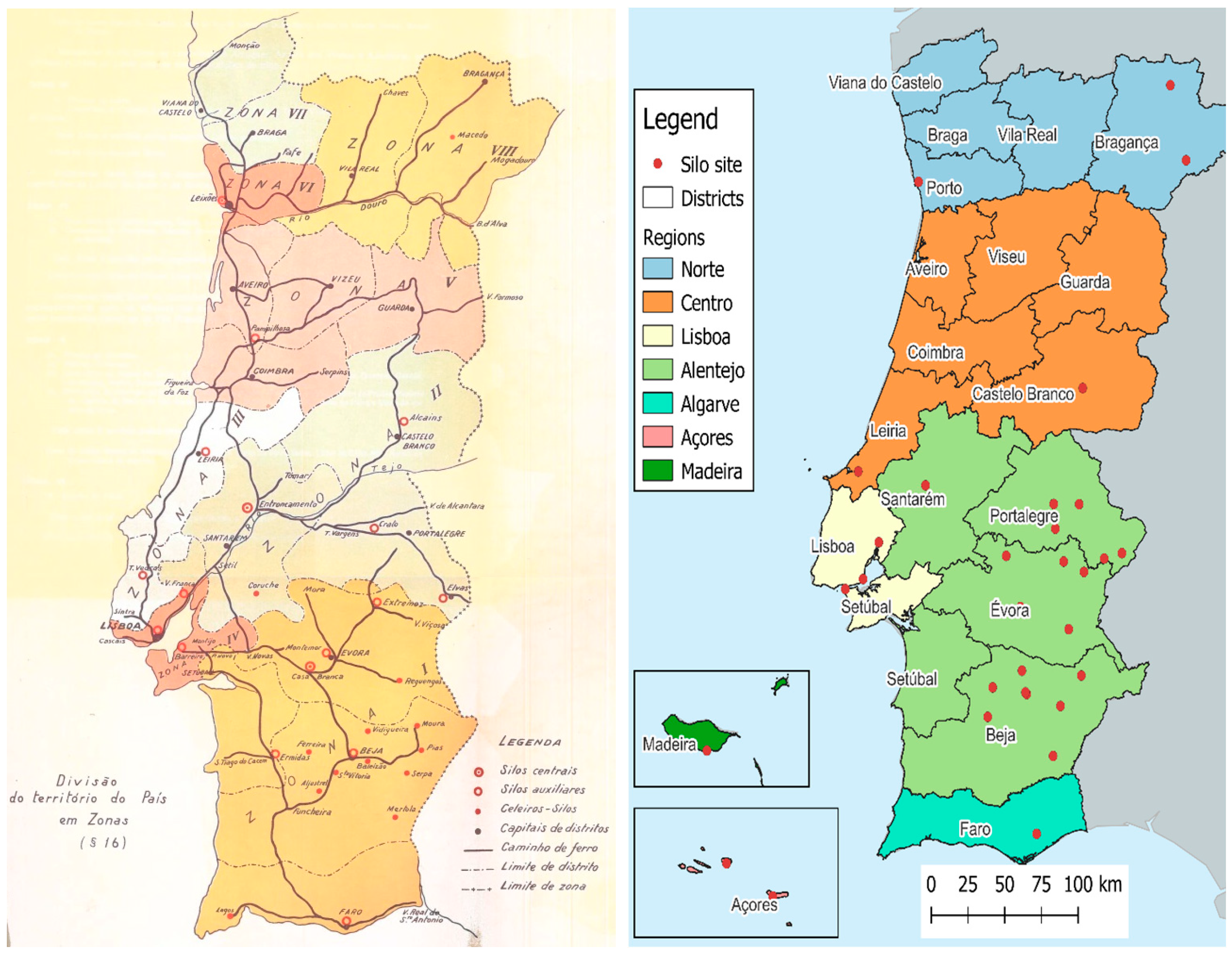
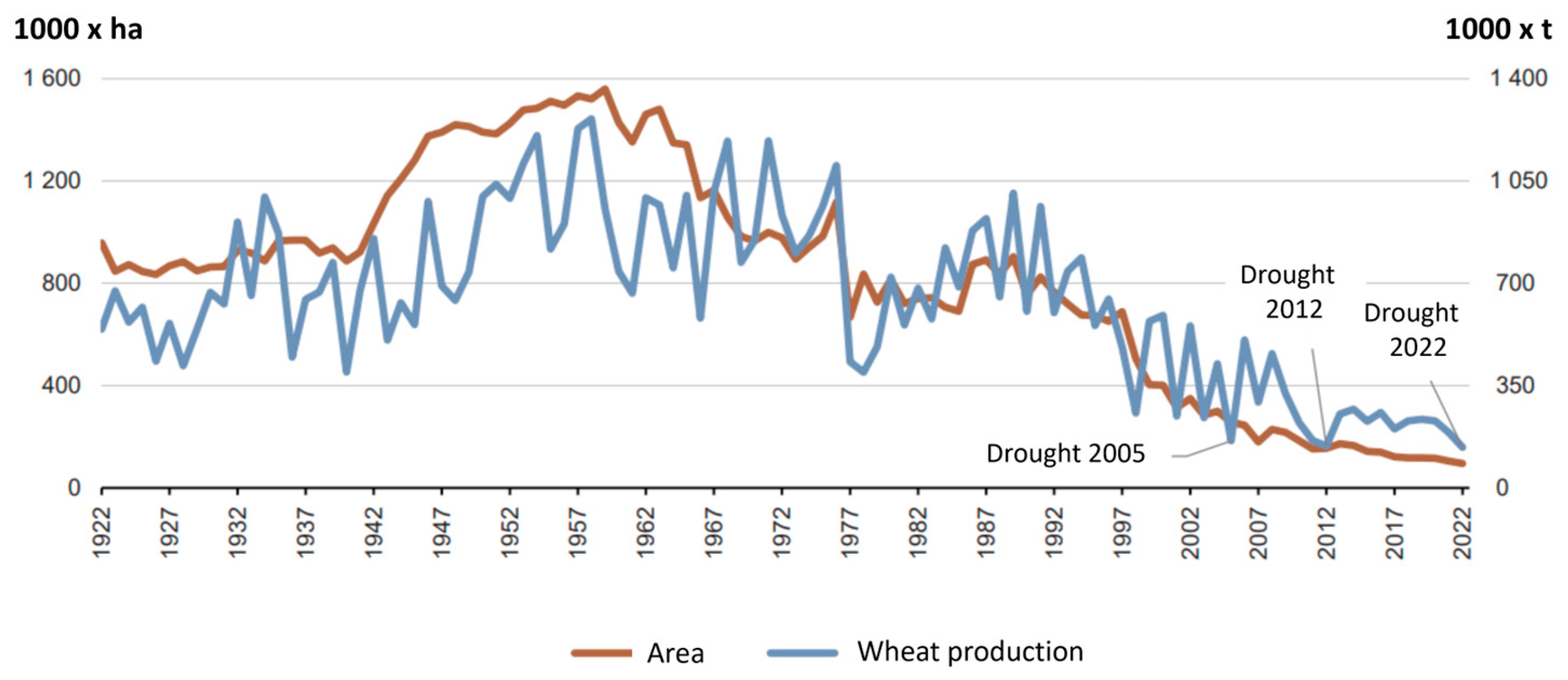
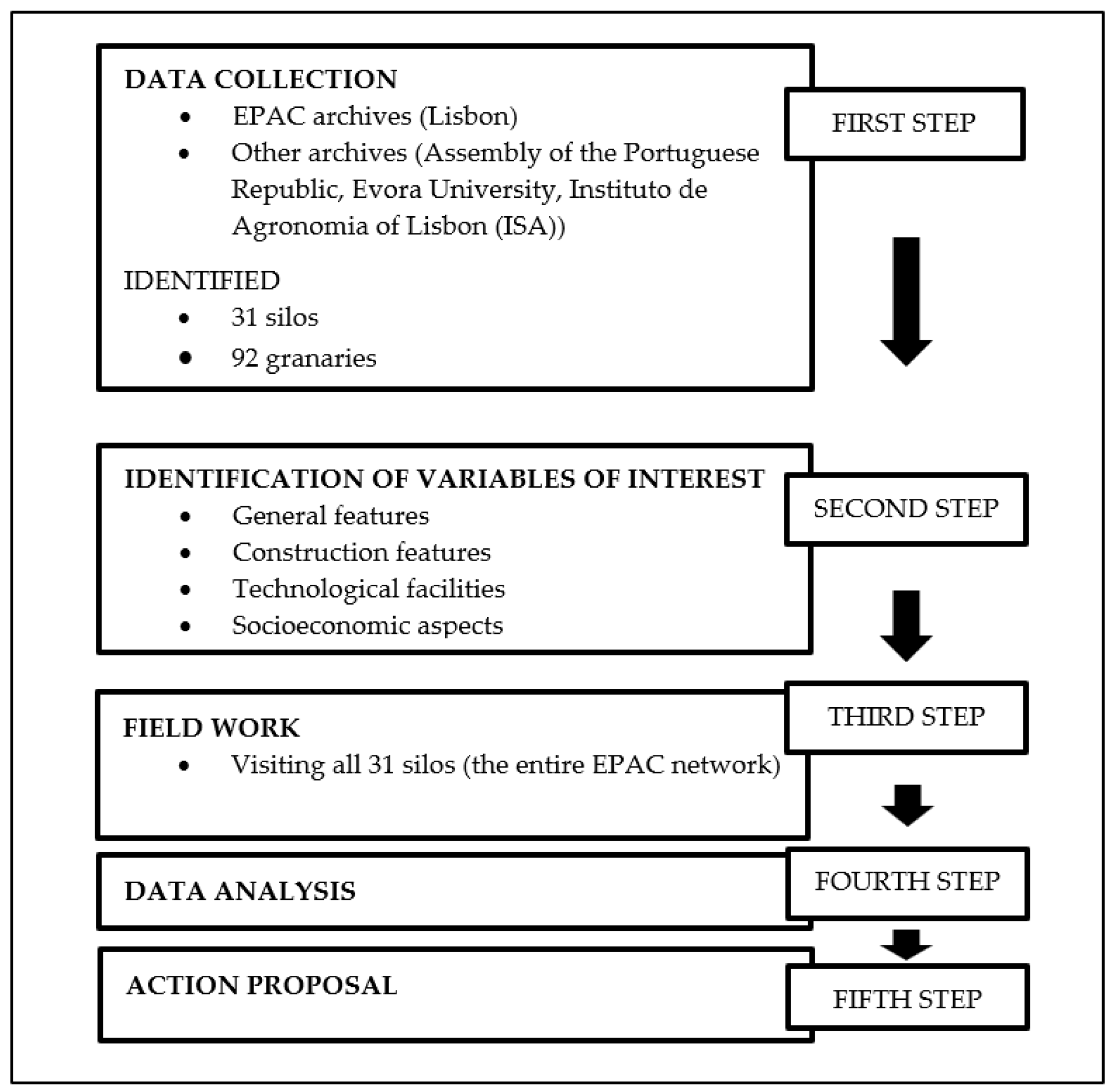
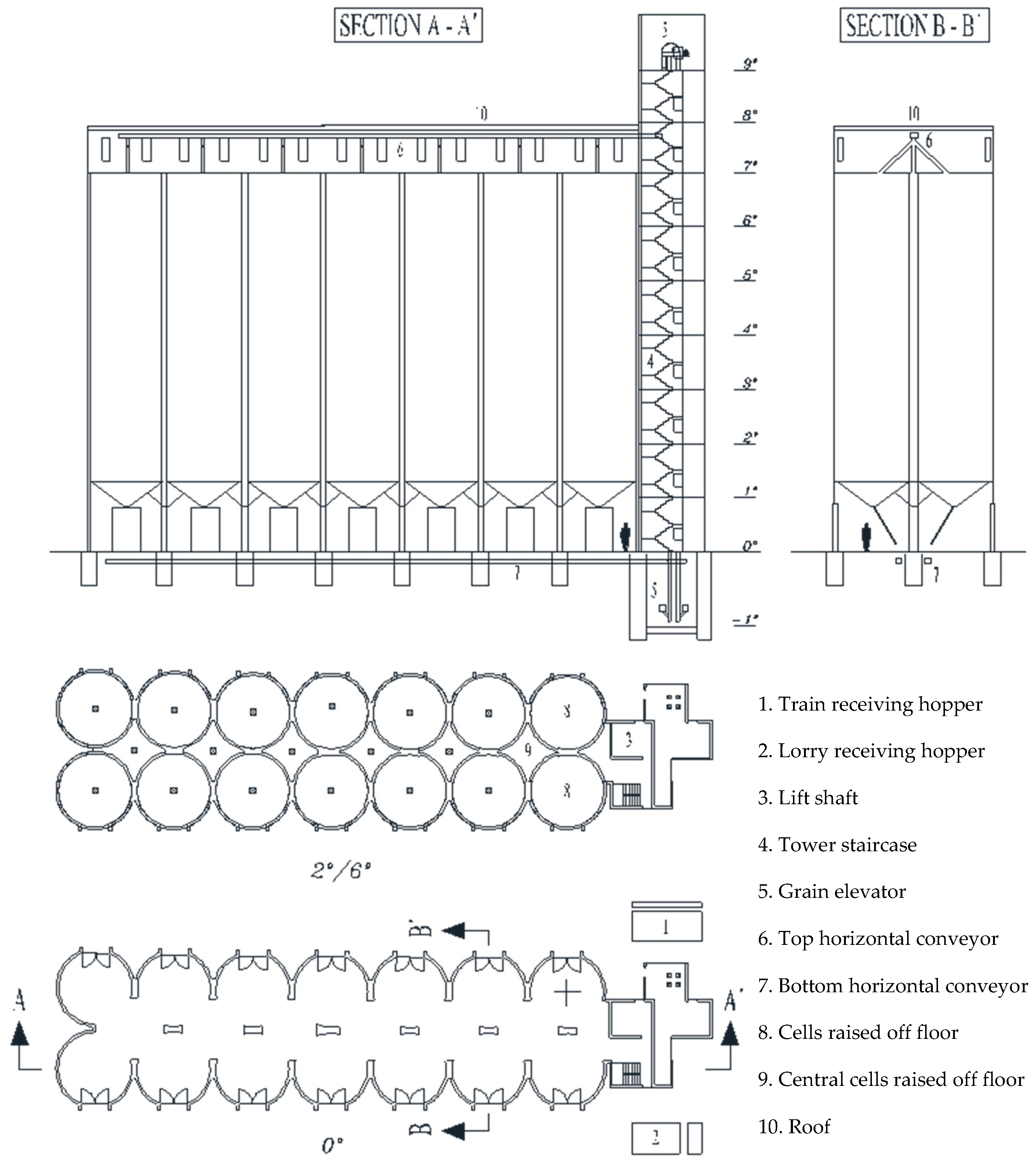
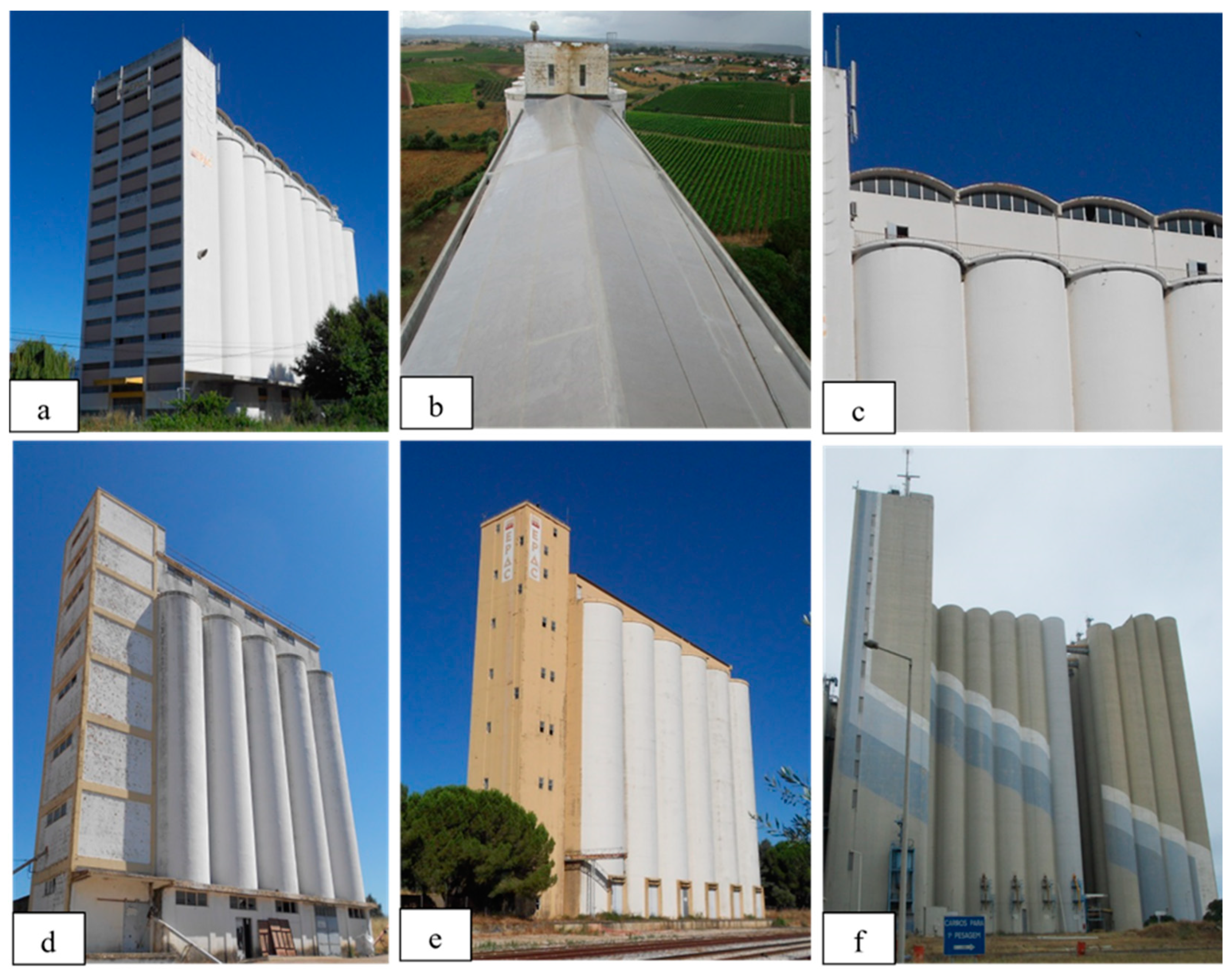
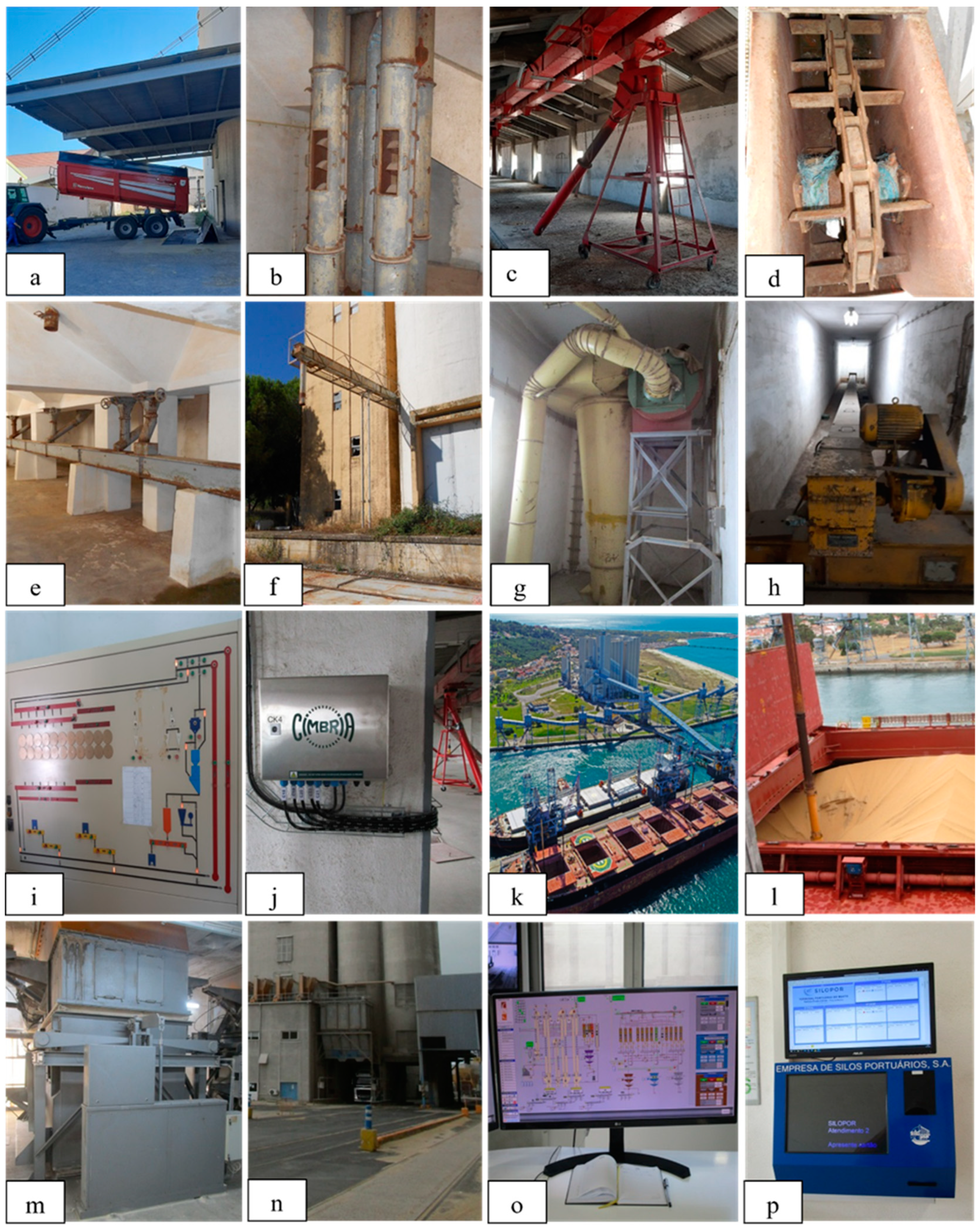
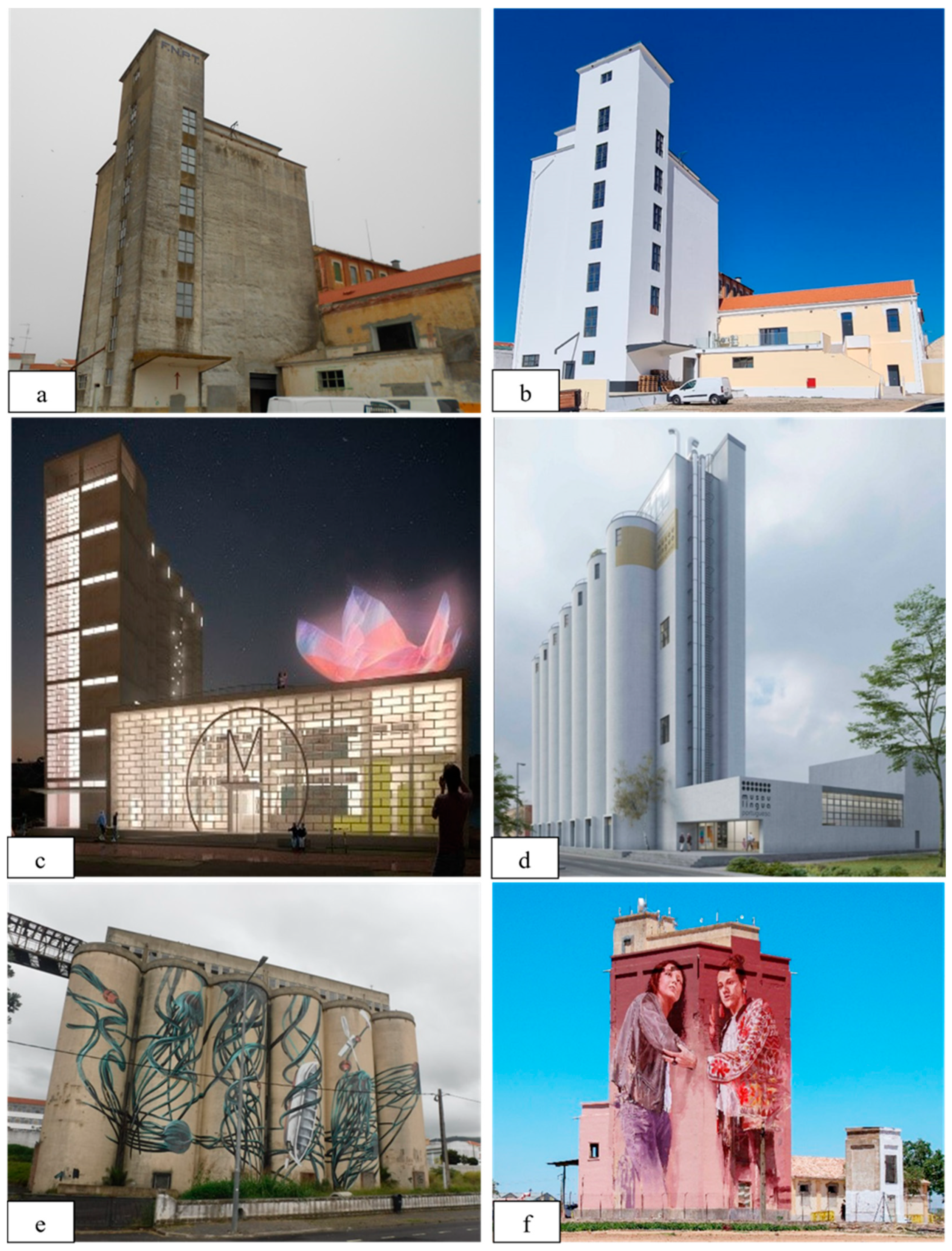
| Categories | Variables of Interest |
|---|---|
| General features | Region |
| District Town | |
| Geolocation | |
| Year when built Ownership (state-owned; leased to cooperative, institute, or private company; owned by private company or municipality) Use State of conservation | |
| Morpho-typology and construction features | Category |
| Storage capacity (t) | |
| Height (m) Ground plan | |
| Roof shape | |
| Tower position | |
| Number of storage cells Number of rows of cells Number of rows of internal cells or intercellular spaces Cell shape Cell dimensions Façade types (straight or semicircular type I, II, or III) Cell construction material | |
| Technological facilities | Receiving machinery capacity (t/h) Number of elevators Number of upper-storey horizontal conveyors Number of lower-storey horizontal conveyors Existence of firefighting system Existence of lift Existence of temperature sensors Existence of railway |
| Lorry weighbridge (t) | |
| Railway weighbridge (t) | |
| Socioeconomic aspects | Population Demographic patterns Yearly municipal budget (EUR) Economic activity Land communications |
| Distances to larger urban centers (km) |
| EPAC Network | |||
|---|---|---|---|
| Region | Town | Capacity (t × 1000) | |
| Alentejo | Inside Beja | 15.0 | |
| Alentejo | Outside Beja | 26.5 | |
| Alentejo | Alter do Chão | 8.0 | |
| Alentejo | Estremoz | 16.0 | |
| Alentejo | Evora | 23.0 | |
| Alentejo | Fronteira | 16.0 | |
| Alentejo | Vila Viçosa | 2.3 | |
| Alentejo | Pavia | 18.0 | |
| Alentejo | Reguengos de Monsaraz | 35.0 | |
| Alentejo | Moura | 10.0 | |
| Alentejo | Serpa | 19.0 | |
| Alentejo | Mértola | 4.5 | |
| Alentejo | Portalegre | 10.0 | |
| Alentejo | Vila de Boím | 4.0 | |
| Alentejo | Ferreira do Alentejo | 23.5 | |
| Alentejo | Aljustrel | 14.5 | |
| Alentejo | Elvas | 15.0 | |
| Alentejo | Cuba | 23.5 | |
| Centre | Alcains | 10.0 | |
| Centre | Vale de Figueria | 24.0 | |
| Centre | Caldas de Rainha | 6.5 | |
| Lisbon | Vila Franca de Xira | 6.5 | |
| Lisbon | Beato | 120.0 | |
| Lisbon | Trafaria | 200.0 | |
| North | Mogadouro | 6.0 | |
| North | Braganza | 12.0 | |
| North | Leixões | 100.0 | |
| Madeira | Funchal | 16.0 | |
| Azores | Punta Delgada | 34.0 | |
| Azores | Angra do Heroismo | 21.0 | |
| Algarve | Santa Catarina da Fonte do Bispo | 1.3 | |
| Total | 31 silos | Total | 841.1 |
| Category | Total | Min. | Max. | Mean | Silo Distribution in Percentages |
|---|---|---|---|---|---|
| Region | 7 | 58.1% Alentejo; 9.7% Lisbon; 9.7% Centre; 9.7% North; 6.5% Azores; 3.2% Madeira; 3.2% Algarve | |||
| District | 25.8% Beja; 16.1% Evora; 16.1% Portalegre; 6.5% Lisbon; 6.5% Braganza; remaining districts each contain 3.2% of the silos in the network | ||||
| Town | 30 | ||||
| Year when built | 1938 | 1986 | 1970 | ||
| Year when expanded | 1962 | 1985 | 1977 | ||
| Ownership | 36.7% leased to cooperatives; 33.3% state-owned; 13.3% leased to private companies, 10.0% owned by private companies; 3.3% owned by municipalities; 3.3% leased to institutes | ||||
| Use | 51.6% grain store; 38.7% disused; 9.7% reused | ||||
| State of conservation | 51.6% good condition, 33.3% fair condition, 9.6% unusable, 6.5% demolished | ||||
| Category | 3 | ||||
| Capacity (t × 103) | 2300 | 200,000 | 27,132 | ||
| Height (m) | 26 | 70 | 43.2 | ||
| Ground plan | 96.7% square; 3.3% L-shaped | ||||
| Roof shape | 53.4% flat roof; 40.0% gable roof; 3.3% flat and gable roof; 3.3% vaulted roof | ||||
| Tower position | 83.4% front tower; 6.6% corner tower; 6.6% interior tower; 3.4% side tower | ||||
| No. storage cells | 11 | 157 | 36 | ||
| No. rows of cells | 2 | 4 | 2.4 | ||
| No. rows of internal cells or intercellular spaces | 1 | 3 | 1.5 | ||
| Cell shape | 93.3% circular; 6.7% square | ||||
| Cell dimensions | 2 | 13 | |||
| Façade types | 6.7% straight; 16.7% semicircular I; 53.3% semicircular II; 23.3% semicircular III | ||||
| Construction material | 93.3% reinforced concrete; 6.7% reinforced brick | ||||
| Receiving machinery capacity (t/h) | 50 | 3000 | 195.6 | ||
| No. elevators | 2 | 14 | 3.2 | ||
| No. upper-storey horizontal conveyors | 1 | 10 | 2.6 | ||
| No. lower-storey horizontal conveyors | 1 | 9 | 2 | ||
| Firefighting system | 53.3% yes; 46.7% no | ||||
| Lift | 85.7% yes; 14.3% no | ||||
| Temperature sensors | 86.6% no; 13.3% yes | ||||
| Railway | 56.7% yes; 43.3% no | ||||
| Lorry weighbridge (t) | 30 | 100 | 66.4 | ||
| Railway weighbridge (t) | 200 | 200 | 200 |
Disclaimer/Publisher’s Note: The statements, opinions and data contained in all publications are solely those of the individual author(s) and contributor(s) and not of MDPI and/or the editor(s). MDPI and/or the editor(s) disclaim responsibility for any injury to people or property resulting from any ideas, methods, instructions or products referred to in the content. |
© 2024 by the authors. Licensee MDPI, Basel, Switzerland. This article is an open access article distributed under the terms and conditions of the Creative Commons Attribution (CC BY) license (https://creativecommons.org/licenses/by/4.0/).
Share and Cite
Marcelo, V.; Almeida, A.; Pastrana, P.; López-Díez, F.J.; Valenciano, J.B. The Origin and Architectural and Technological Characteristics and Opportunities for the Reuse of Portugal’s EPAC Silo Network. Sustainability 2024, 16, 2116. https://doi.org/10.3390/su16052116
Marcelo V, Almeida A, Pastrana P, López-Díez FJ, Valenciano JB. The Origin and Architectural and Technological Characteristics and Opportunities for the Reuse of Portugal’s EPAC Silo Network. Sustainability. 2024; 16(5):2116. https://doi.org/10.3390/su16052116
Chicago/Turabian StyleMarcelo, Víctor, Arlindo Almeida, Pablo Pastrana, F. Javier López-Díez, and José B. Valenciano. 2024. "The Origin and Architectural and Technological Characteristics and Opportunities for the Reuse of Portugal’s EPAC Silo Network" Sustainability 16, no. 5: 2116. https://doi.org/10.3390/su16052116
APA StyleMarcelo, V., Almeida, A., Pastrana, P., López-Díez, F. J., & Valenciano, J. B. (2024). The Origin and Architectural and Technological Characteristics and Opportunities for the Reuse of Portugal’s EPAC Silo Network. Sustainability, 16(5), 2116. https://doi.org/10.3390/su16052116






